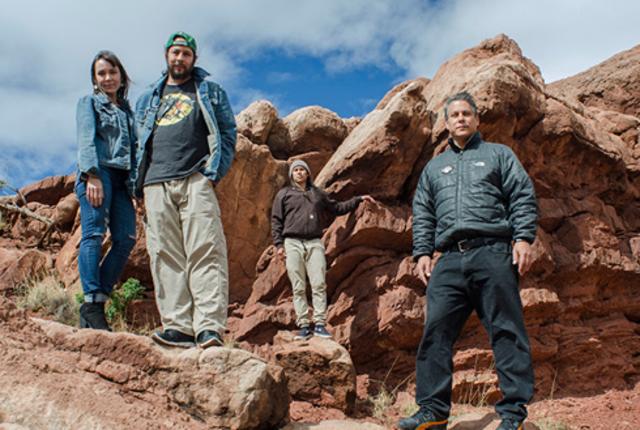(above) The Romeros on the rocks near their ancestral Cochiti Pueblo.
From left: Cara, Diego, Santiago, and Mateo.
MARKETS IN MOTION
Though it’s enjoyed international acclaim since its founding in 1922, the Santa Fe Indian Market, which takes place during the weekend of August 22–23, is always pushing its own boundaries. Along with its traditional presence on and around the Plaza, this year the Indian Market is hosting a contemporary show at the Santa Fe Community Convention Center. Rima Krisst, a coordinator at the Southwestern Association for Indian Arts (SWAIA), the organization that produces Indian Market, says of the organization’s CEO, Dallin Maybee, “He’s an artist himself, and he has a great deal of respect for our youth, and for people who are creating very cutting-edge artwork.”
Fashion is always one of the market’s biggest draws; this year’s features two shows—a traditional one on the Plaza bandstand Sunday morning, and one dedicated to contemporary pieces in Cathedral Park Saturday afternoon. The latter “features gorgeous items with traditional elements created by some of today’s top Native American designers,” Krisst says, adding that “the makeup and hair are always very edgy and beautiful.” (505) 983-5220; swaia.org
Just in its second year, the grassroots Indigenous Fine Art Market takes place August 20–22 in the Railyard Park. The juried event features more than 350 exhibitors. “It’s run as a cooperative—all of the artists really own a part of it,” says IFAM president and founder John Torres Nez. “And we use the word ‘indigenous’ for a reason, because although we primarily show Native American art, we do invite artists from Hawaii, New Zealand, Australia, and other native cultures around the world.” Open until 9 all three evenings, IFAM offers pop-up tribal dance performances, films at Jean Cocteau Cinema, and music that ranges from traditional to hip-hop and heavy metal. (505) 819-3695; indigefam.org
—Andrew Collins
For Diego Romero, Indian Market was over before it started. After more than 20 years as a prizewinning contemporary potter, he had just one ambition left—to win Best in Show—and he’d blown his annual chance. Not that there was any shame in losing. The Southwestern Association for Indian Arts’ (SWAIA) August extravaganza is the largest Native art market in the country, and its thousand or so vendors have a dizzying range of talents, from precontact-style stone jewelry to digital graphic art. Only one piece can win Best in Show. But Diego hadn’t lost. In fact, he hadn’t even competed. Somehow, between picking up the kids from their Santa Fe daycare, tending to ceremonial duties at Cochiti Pueblo, and all the niggling distractions that can keep an artist from his studio, he’d just miscalculated. When the judges made their pre-market rounds on Wednesday, his pot was still on a table at home, awaiting its finishing brushstrokes.
Cara Romero, Diego’s wife of four years, wouldn’t have missed judging for the world. In 2013, after a decade of intermittently showing her photography at Indian Market, she had finally hit it big. Instead of submitting one of the landscapes she’d shot that year near the California Chemehuevi reservation, where she grew up—“Joshua tree country,” she calls it—Cara had found herself drawn to a family portrait she’d taken as an afterthought: Diego’s adult son Santiago standing on the center stripe of a desert road, hoisting Paris, Cara and Diego’s infant son, aloft against the sunset. The resulting panorama, Nipton Highway, was both epic and intimate. SWAIA judges awarded it Best in Division, a prize just one level below Best in Show. Now, returning to Indian Market a year after her first big success, she’d submitted a new photograph that had earned her a second consecutive Best in Division award, continuing a scintillating run heralding her as an emerging force in Native art world. It was going to be a good weekend.
Viewed from above, opening day at Indian Market might resemble a great spiral galaxy spinning out from the Santa Fe Plaza. Each year thousands of turquoise-bedecked shoppers crowd the streets before sales open, clutching large coffees and puzzling over maps and booth listings. Inevitably, many gravitate to the show’s biggest stars. On Saturday morning it didn’t take long for Diego to unload his lone vessel to one of the circling collectors for a five-figure check and escape to the movies with his kids. (One-Pot Romero, a friend calls him.) Cara stayed behind in their booth with her prizewinning prints, established at last at the center of her own orbit.
On the other side of the Plaza, along the galactic arm that stretches north up Lincoln Avenue, Mateo Romero was faring similarly well. Diego’s younger brother works in paint, not pottery. For Indian Market he unveiled a new style, a series of New Mexico landscapes done in thick oil impasto, which the public was snapping up along with the multimedia paintings of Native dancers for which he’s known. His canvases rotated so quickly that it was possible to wander down to the end of the street and fail to recognize his booth on the way back. By Sunday, the young Jemez artist Jaque Fragua would talk Mateo into wearing a T-shirt that said famous indian artist, and it wouldn’t even seem boastful.
Only Santiago Romero, the young man from Cara’s photograph, was faced with an uncertain market. Long-haired and athletic at 27, Santi (his family emphasizes the second syllable) was on his third Indian Market. His ceramic work had sold well his first time out, and his second market, though less remunerative, won him an honorable mention for abstract clay work. It was an auspicious enough start for a SWAIA newcomer, but the market can be inattentive toward younger artists, even those with famous last names. As Saturday marketgoers streamed past his careful display of pots and figurines, Santiago’s sales pitch took on a note of self-mockery. “I’m selling smoke and mirrors,” he called to the crowd. “I’ll tell you what you want to hear.”
Two women stopped to browse. Santi slipped into his patter, explaining both the traditional and scientific significance of the symbols on his bowls, which combined conventional lightning and corn motifs with references to the Haber-Bosch process. The women listened with interest, then thanked him and moved on. Santiago seemed unfazed. Patience was key. In case business slowed too much, he’d planned out some costume changes—different outfits, different hairstyles, glasses, no glasses—to keep things fresh around his booth. The weekend was long, and you never knew what might get people interested in your art.
But the truth was that, whether or not you were making money and winning prizes, showing up to Indian Market each year was the easy part. All those months in between were where artists’ lives got interesting.
Growing up at Cochiti Pueblo in the early 20th century, Teresita Chavez Romero was taught the traditionally feminine craft of shaping and firing local clay to make cream-colored polychrome vessels. As a young woman, she showed enough talent that her work likely reached Santa Fe, a 40-mile trip east, where the wave of tourists and anthropologists arriving on the railroad transformed Puebloan pottery and crafts from utilitarian goods to hot commodities. An art market was born. Families like the Romeros could head into “town,” as they called the capital, swap pots and trinkets for dry goods, and return to their villages as professional artists. The best were invited back for Indian Fair, which was started in 1922 with a presumptuous mandate to “teach buyers and potters to differentiate good from bad pottery,” former SWAIA director Bruce Bernstein writes in Santa Fe Indian Market: A History of Native Arts and the Marketplace.
In addition to her pots, Teresita made the sort of ceramic figures that Cochiti had specialized in during the 19th century. One type at which she excelled, the “Singing Mother,” was a predecessor to Helen Cordero’s storyteller figurines, which in the 1960s would take Indian Market by storm and become indelibly associated with Cochiti art.
Teresita’s son, Santiago, was a storyteller himself. Drafted by the Marine Corps, he was wounded in action in Korea and sent to recuperate in the Bay Area, where he fell in love with a UC Berkeley anthropology student. Their two sons, Diego and Mateo, would listen with rapt attention to Santiago’s accounts of Corsairs dogfighting over Guadalcanal, shredding enemy planes to fiery confetti in the night sky. They also picked up his love of art, which he’d studied under Dorothy Dunn, the Santa Fe Indian School teacher who helped found a Pueblo painting tradition by arming her students with watercolors and sending them out to depict village life. In his adult work, Santiago tried to marry the ethnographic Dunn School style to a Japanese woodblock aesthetic, but found his pieces dismissed at Native art competitions as “impure.” The boys, unconcerned with purity, competed to see who could draw better renditions of Marvel comic-book characters.
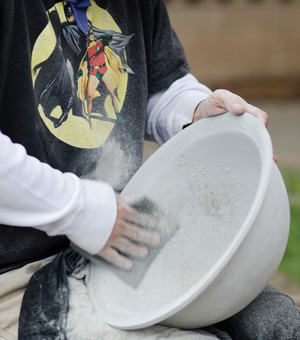 Diego sanding a piece in preparation for Indian Market.
Diego sanding a piece in preparation for Indian Market.In his late teens, Diego uprooted for New Mexico, where he landed at the Institute of American Indian Arts (IAIA). He was assigned to room with Tony Abeyta, who would become a star painter and a lifelong friend. Although Diego dreamed of making a living as a comic-book artist, Abeyta talked him into taking Traditional Pottery I, where Diego and his Hopi instructor immediately hit it off: “She told me, ‘You’re going to be a famous artist one day. Anything you want to learn, just ask.’”
Together, Diego, Abeyta, and a coterie of their IAIA classmates became the enfants terribles of the Santa Fe art world. Mateo arrived fresh from Dartmouth in 1989 and immediately took to the scene. “The color and the light, the energy and the beautiful women, all this stuff is in the air, and there’s just wonderful art coming out of this place,” he recalls. “I was like, ‘This is what I want to do.’ ”
The new generation won acclaim at Indian Market while experimenting in both art and hedonistic living. Their work stood out for its vigor and acerbic social commentary. Above all, they refused to be bound by the traditional styles of cultures they felt were not wholly their own, preferring to embrace the full breadth of their artistic education. They admired groundbreaking Indian artists like Fritz Scholder, but also non-Native influences from California, New York, and beyond. As Diego says, “I wasn’t an orthodox Cochiti Indian, so why be an orthodox Cochiti potter?”
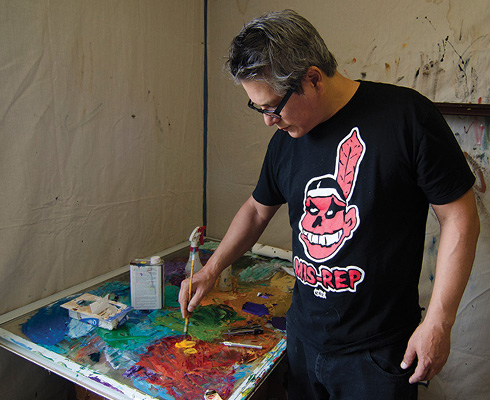 Mateo Romero, pictured at his home studio near Pojoaque, found success at Indian Market with multimedia paintings of Native dancers, such as Deer Dancer with Avanyu.
Mateo Romero, pictured at his home studio near Pojoaque, found success at Indian Market with multimedia paintings of Native dancers, such as Deer Dancer with Avanyu.
In September of last year, not long after Indian Market, I visited the younger Santiago, Diego’s son, at home on Upper Canyon Road. “Home” in this context was a flexible term; the little adobe house on an unpaved hill was Mateo’s studio. The arrangement recalled Mateo’s own decade as a struggling artist, when he had bounced among family and friends, painting in any garage or kitchen he could. Diego had been particularly generous toward his little brother, letting him share studio space whenever he needed it.
Santi’s living requirements were minimal: a mattress on the floor of a room that was really more of a nook, a curtained reading space where an odd assortment of art books commingled with Game of Thrones DVDs. The walls were hung with Oakland Raiders paraphernalia, an affiliation he’d inherited from his dad. Santiago grew up mostly on the other end of California, in Los Angeles, with his mom. Summers were spent with the noted Santa Clara sculptor Roxanne Swentzell, another of Diego’s old flames, whom Santi credits with teaching him to work with his hands.
Uncle and nephew worked back to back in the house’s main room, a hollow space lined on one side with Mateo’s paint-spattered surfaces and on the other by a workbench that held Santi’s unfinished clay objects. Crates of vinyl, mostly Mateo’s, were stacked at the back of the room; by agreement, Fleetwood Mac’s Rumours was in heavy rotation on the turntable. Santiago had mounted a collection of stylized longboards on the wall above the coyote bowl he was working on.
Outside the open door, a huge painting awaiting a delivery truck was balanced on the front steps, wobbling in the gusts of wind before a thunderstorm. For prolific sellers like Mateo and Cara, the weeks following Indian Market are given over to packaging and shipping orders to all parts of the country. Collectors and artists share a bond that often goes beyond the merely transactional. Some will fly Mateo in to oversee the installation of a painting in their home. Of her own collectors, Cara says, “There’ve been a lot, but I think I could recognize every single one of them and call them by name. Some of them are returning customers. Some of them aren’t, and I like to get their artwork to them right away and make it a really good experience for them.”
Those interpersonal relationships become especially important in lean times. After booth fees and miscellaneous expenses, Santiago had more or less broken even at Indian Market. His task for the fall would be to make the rounds with collectors, trying to sell off his remaining inventory before the Santa Fe art market hit its annual doldrums. He’d met many of the people on his shortlist through his uncle. This, more than any point of craft, is the knowledge at the heart of the Romero family business. It has to be. Some families hand down pottery techniques that haven’t changed for generations; the Romeros are imparting ways to survive as an artist.
In the studio, the three of us drank tea while Mateo held forth on what he called the taboo subject of the economics of art. To the extent that it exists, this taboo is enforced mostly by art consumers; among producers, talking about mailing lists and marketing strategies is as normal as discussing paydays and retirement accounts is to the rest of us. “At some point you’ve already put the chains on, and you are selling something, so let’s be honest about it,” Santiago said. The Native art circuit has annual routes and rhythms. In the months after Indian Market, one artist they know packs a truck and totes his wares all over the West, stopping at ski towns and regional fairs to eke out a living. “We’re migrant art sharecroppers,” Mateo joked. “We’re following the strawberry crop of art.”
When I next ran into Santiago, at a Santa Fe coffeehouse in November, his harvest had come in. While trying to sell some masks left over from Indian Market, he’d set up a meeting at Buffalo Thunder Resort & Casino, which has what Mateo calls “arguably the most interesting contemporary Native collection anywhere.” Although his buyer didn’t bite, the masks’ Mesoamerican influences struck a chord, and Santi walked away with a considerable commission to create work to decorate the hotel’s new Mexican-themed Iguana Café. The paycheck would help tide him over through the winter.
Executing commissions wasn’t quite the same as creating his own art, but it was a good chance to develop his technique. When he moved to Santa Fe after graduating from Dartmouth with a degree in environmental science, Santiago had first looked for museum work before gradually being drawn into creating art himself. “I saw my father across the table, working, and I was like, ‘I can learn from somebody, even if it’s just by osmosis,’” he says. To work on his skills as a ceramist, he spent three years in the studio as a virtual recluse, frequently without a computer or phone. (This was another tactic he learned from his father, who conducts all of his distance communications through Cara in order to better focus on his art.) Sometimes he would go days without talking to anyone at all.
Artists’ social lives, not to mention their finances and self-esteem, can be awfully unstable. One bad Indian Market can set off a tailspin of loneliness and doubt. “Winter comes, and you’re here all alone, pacing back and forth, thinking, is this a waste of time? If I don’t make it, what am I going to do? I’ve invested a lot of time and patience and energy into this, building it, and it’s turned against me,” Santiago says.
When they were Santi’s age, still trying to find their footing in the art world, Diego, Cara, and Mateo all struggled with alcoholism. The toll on both their work and their relationships was heavy. After Indian Market, Diego would sometimes leave his children on the Plaza to go spend his earnings at the bar. “I remember one time we were at Evangelo’s,” Diego says. “They have that big, long window, and Santi’s head kept popping up. Someone at the bar said, ‘Hey, there’s some kids out there.’ He looks at them, and he goes, ‘Who leaves their kids outside a bar?’ I go, ‘I don’t know, probably some [jerk].’ Then he goes, ‘He’s pointing at you!’” His storyteller’s grin fades into a reflective stare. “I laugh about it now, and probably Santi laughs about it now, but it’s not funny at all.”
Santiago grew up estranged from his father. Rebuilding their relationship after he moved to Santa Fe was a deliberate process. Sharing art helped, and so did dancing together at Cochiti ceremonies. Their tribes’ spiritual grounding and communal ties offer the sort of support the Romeros have sought out in their sobriety. Most of all, it helps to have one another. “We were all in the throes of it, as Indian artists and Indian people from diverse backgrounds. Alcohol paradigms are just woven in, unfortunately, to our experiences as Indians,” Cara says. “But we all overcame it, and we lean on each other really heavily.”
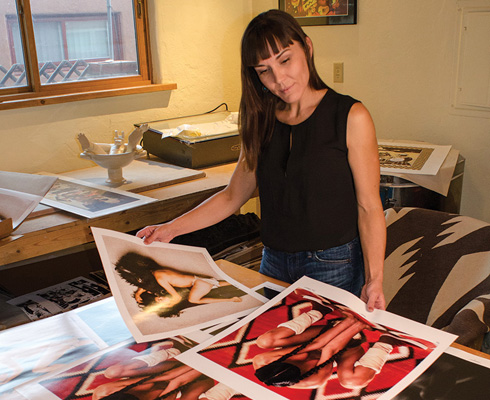 Cara Romero’s fine art photography has won awards at recent competitions.
Cara Romero’s fine art photography has won awards at recent competitions.
These days, their devotion to supportive relationships comes before anything, even art, though the two typically go hand in hand. While Santiago worked on his Buffalo Thunder commission, Cara was experimenting with the type of elaborate photographic productions that Diego had been encouraging her to try. In collaboration with the Choctaw multimedia artist Marcus Amerman, she dreamed up a rendition of Leonardo’s The Last Supper that would feature well-known friends from around the Indian art world in the poses of the apostles. Amerman himself, wearing an enormous buffalo head, filled in for Jesus. Diego wryly volunteered for the role of Judas.
If the August Indian Market in Santa Fe offers a pole by which Native artists can orient their year’s work, the Heard Museum Guild Indian Fair and Market is its spring antipode. In March, Mateo and Cara made the usual trip—what Cara calls the “great migration”—to Phoenix to show their work there. Both had considerable success. For Mateo, this was nothing out of the ordinary; for Cara, it was her best market yet. She submitted The Last Indian Market, her Leonardo-style piece, for judging and won a Best in Division award for photography, marking her fourth straight triumph in a major competition.
When I visited Diego and Cara at home in early May, she was still glowing. “I never really thought it was possible to be doing as well at photography as I’m doing right now. It never played out in my head this way. It was always for the love of it,” she said. Diego, who has witnessed this sort of ascent before, beamed proudly. Cara likes to say that the first time she met her husband was “literally in my Native art history class, when we got to contemporary artists”—there he was, in the textbook, a boldface name. Now it was her turn to be invited back to IAIA as a lecturer. She made sure to bring her student work, she said, to offer the class a testament to the learning curve.
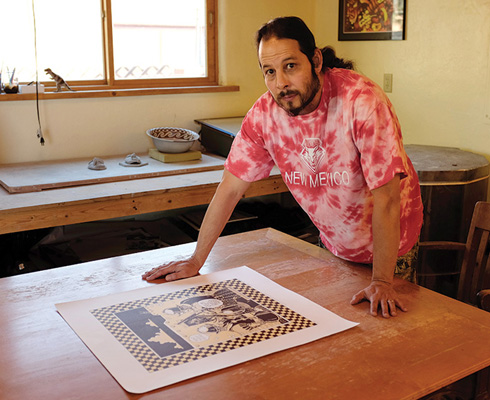 Diego Romero with a new print at his Santa Fe studio.
Diego Romero with a new print at his Santa Fe studio.
Diego, too, was making good on an ambition from his student days. On the table in his studio was a print he’d just completed for Landfall Press, a comic-book-style panel of a conquistador named Diego menacing frightened Native women, who took refuge in a church. Though it was inspired by the Pueblo Revolt, he pointed out that the scene could just as easily have been set in classical Rome or 21st-century Iraq. He’d been so pleased with how the print turned out that he was thinking of showing it at the coming Indian Market alongside his pottery.
Lately, inspired by conversations with Cara, who’s an active environmentalist, Diego’s pots have started to depict the consequences of climate change. It’s a concern all four Romero artists share. Content—that’s what’s always set them apart: a piece doesn’t have to be technically perfect as long as it has something to say. For her next Indian Market judging piece, Cara was planning to attempt her first underwater shoot. Her idea for it drew on both global warming and the story of her own Chemehuevi ancestral territory, much of which had been destroyed by the creation of a man-made lake.
“One part of it is kind of set in the past, with all the floodings that have happened,” she said. “And then one part of it is set in this great flood that’s about to happen.”
Keeping the long view can be a challenge sometimes. Just surviving from one Indian Market to the next requires a certain amount of what Cara calls keeping your soul on fire—holding on to the inspiration that separates art from cynicism and drudgery. Mateo often talks about painting in romantic terms. “You have to be able to allow yourself to feel like it’s the first kiss all over again. Because people can feel that,” he says.
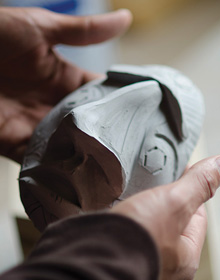
Santiago Romero is making a name for himself with clay pieces like this mask he created in the Santa Fe studio he shares with his father, Diego.
One way to manage this is to think in terms of legacy, although that’s generally easier for artists who are already in textbooks than for those still crashing on family couches. Santi’s dreams of making art that will outlast him—his latest project is a series of bird pots inspired by Yeats’ “The Second Coming”—are tempered by thoughts more typical of a guy in his twenties: the possibility of grad school, a girlfriend trying to get him to move to Phoenix. How much he’s willing to put up with for the sake of art is a personal question, his father and uncle acknowledge, but he’s already come a long way. “He’s very talented,” Diego says. “I truly believe it's in the DNA. It’s a gift from the wind.”
One weekend in the spring, I rode with Santiago and Mateo out to the Galisteo Basin to look for some petroglyphs Mateo had read about. We didn’t have much of an idea where we were going, just a crude map on Mateo’s phone and a mention of some basalt ridges where the rock art was supposed to be. We pulled off the highway by some stegosaurus-looking humps and hiked up the hill to try our luck.
As we picked our way between rough boulders the color of dried blood, the valley spread below us on either side, bounded on the north by the snow-dusted Sangre de Cristos. It was easy to see why Puebloan people had chosen to live here for centuries—the scenery had the horizontal bands of color and startlingly present clouds that Mateo seeks out for his landscape paintings. We started to spot simple images scraped into the rock: a coyote, a lizard, a grimacing face.
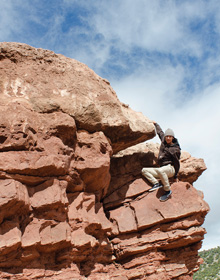
After an hour or so, Santi came across a large design nearly covering a smooth vertical surface. It was a shield panel, exactly the sort of drawing Mateo had been hoping to find. A simple human head and limbs jutted from a round body that represented a warrior’s shield. The face of the shield was the piece’s heart: A lightning bolt divided the circular composition, which was crowded on either side with bear claws, human hands, stars, and a figure holding what looked like a mace. The effect was breathtaking. “I’ve not seen better in all my years climbing these hills,” Mateo said.
Santiago stared in silence. He was supposed to be back in the studio, finishing up a lizard sculpture for Buffalo Thunder, but he’d been happy to set aside the rote work of smoothing out the piece’s surface for a day of fresh air. Now, eyeing the narrow ledge where an artist must have crouched for hours, without the prospect of recognition or pay, to make the shield panel, he was in awe. “And I complain about sanding,” he muttered.
Energized by the discovery, Mateo urged us onward, confident that we’d find more panels. As the afternoon wore on, however, the prospect started to look more and more doubtful. It was hot. Santiago’s knee was bothering him. Eventually, our water ran out. The sensible thing to do was to head back to the car, but Santi hesitated, looking to his uncle, who didn’t seem to mind being a little lost. “How did they use to give directions out here?” Mateo laughed. “Just turn left at the red rock?”
We descended the ridge and kept walking into the desert, picking our way around a desiccated coyote carcass. Songbirds chirruped in the flowering cholla. Beetles crawled over cow patties, though the cattle themselves had long since moved on, leaving half-consumed salt licks in the dust. Somewhere up ahead of us lay the ruins of an old Pueblo, hidden in the folds of the hills, where we were sure to find spectacular art. All we had to do was not turn back.
John Muller is a writer in residence at El Zaguán in Santa Fe.


